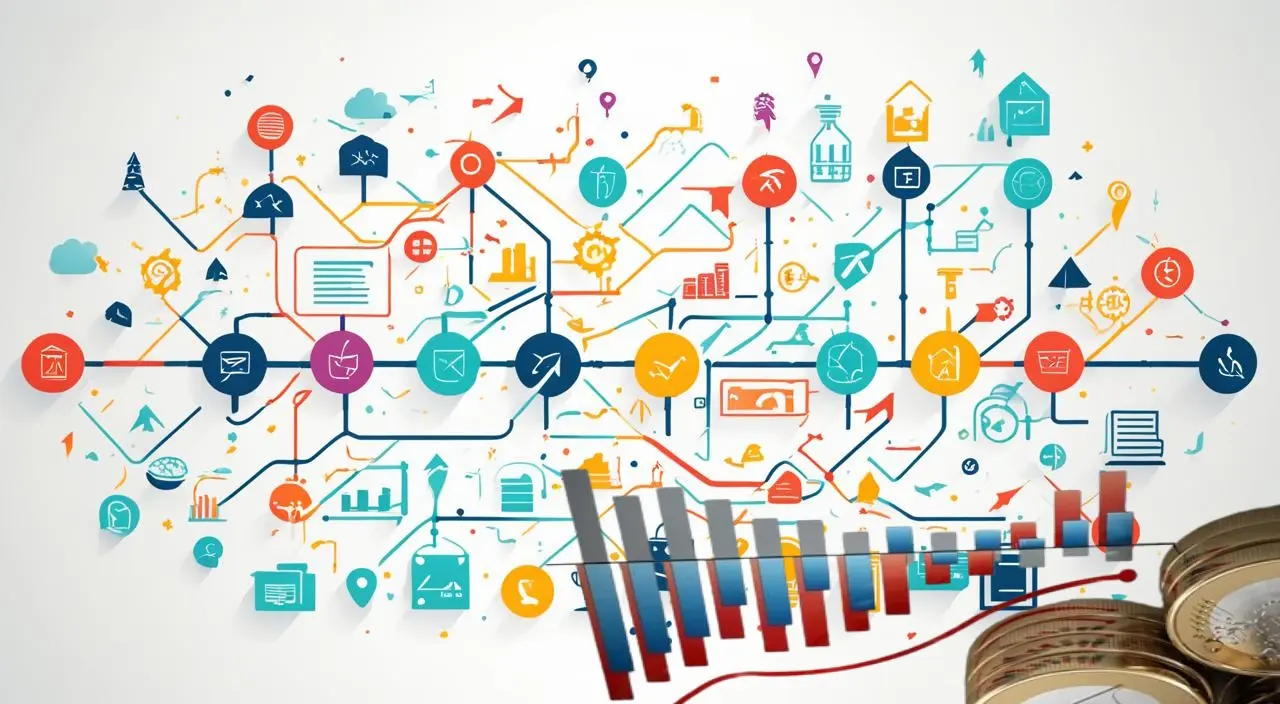Decoding the Economy: Understanding Key Economic Indicators
In today’s fast-paced financial world, knowing about key economic indicators is key. These indicators help us understand the US economy’s health. They cover things like job trends and how fast prices are rising.
By looking at US economic data, people who invest, run businesses and make policy can make better choices. These choices help shape their plans and actions.
Knowing the importance of these indicators helps people predict the future and plan better. This knowledge is crucial for making smart decisions in a changing market. It helps us understand the economy’s performance and make choices that lead to growth.
The Importance of Economic Indicators
Understanding economic indicators is key to knowing a nation’s economic health. These indicators show things like job levels, inflation, and growth. They help us see where the economy stands, making it easier to make smart choices.
Understanding Economic Health
Economic health is shown through various indicators. High job rates often mean a strong economy. But a drop in jobs can warn of trouble ahead. These indicators help policymakers and businesses understand the economy better.
By watching these trends, we can get ready for economic changes.
The Role in Financial Decision Making
Economic indicators are crucial for making financial decisions. They help in assessing risks, setting money policies, and choosing investments. Watching changes in spending and business confidence is key for planning.
Using economic indicators, financial experts can predict economic shifts. This leads to better financial results.
What Are Economic Indicators?
Economic indicators are key to understanding a country’s economy. They give us insights into the current state and future trends. Knowing about economic indicators is crucial for making financial decisions.
Definition of Economic Indicators
Economic indicators are data points that show the economy’s health. They help analysts, policymakers, and investors understand economic performance. By looking at these statistics, we can see how stable and growing the economy is.
Categories of Economic Indicators
There are different types of economic indicators, each giving unique insights. Leading indicators, like new housing starts and consumer confidence, show what might happen next. Lagging indicators, such as unemployment rates and inflation, tell us what happened before. Knowing these helps us predict economic changes.
Types of Economic Indicators
It’s crucial to know the different types of economic indicators to understand the economy’s current state and predict future trends. These indicators are divided into leading, lagging, and coincident types. Each type has its own role and offers important insights.
Leading Economic Indicators
Leading indicators predict future economic activity. Key indicators include stock market performance, new housing starts, and consumer sentiment indexes. These help investors make smart decisions before trends become clear.
Lagging Economic Indicators
Lagging indicators show changes that have already happened. They help confirm long-term trends. Unemployment rates and the Consumer Price Index (CPI) are important examples. These indicators are key to understanding the economy’s health after big changes.
Coincident Economic Indicators
Coincident indicators give us a snapshot of the economy’s current state. They move with the economic cycle, providing up-to-date information. Retail sales and Gross Domestic Product (GDP) are examples. Watching these indicators helps us understand the economy better.
Key Economic Indicators in the US Economy
Understanding key US economic indicators is vital for knowing the economy’s health and making smart decisions. The main indicators are the Gross Domestic Product (GDP), the unemployment rate, and the Consumer Price Index (CPI). These metrics show the economy’s overall state, affecting policy, investments, and how people spend money.
Gross Domestic Product (GDP)
Gross Domestic Product (GDP) is a key indicator, showing the total value of goods and services made in the US. A growing GDP means the economy is doing well, while a drop could mean a recession is coming. By watching GDP, businesses and policymakers can plan better, making decisions on where to invest and how to manage money, leading to a more stable economy.
Unemployment Rate
The unemployment rate is a key sign of the job market’s health. It shows the number of people looking for work. High unemployment means people spend less, which slows down the economy. Keeping an eye on this helps leaders find ways to create more jobs and make the economy stronger.
Consumer Price Index (CPI)
The Consumer Price Index (CPI) is important for tracking inflation, which changes how much money people can buy. It looks at the prices of everyday items, helping us see if living costs are going up or down. Knowing CPI helps businesses set prices and consumers plan their budgets, helping them deal with the economy better.
FAQ
What are economic indicators?
Economic indicators show the current state of the economy and predict future trends. They cover employment, inflation, and growth rates.
Why are economic indicators important?
They are key because they show the economy’s health. They help investors, businesses, and policymakers make informed decisions by showing economic activity clearly.
What are the main types of economic indicators?
There are three main types: leading, lagging, and coincident indicators. Leading indicators forecast future activity. Lagging indicators show past trends. Coincident indicators reflect the current economic state.
Can you give examples of leading economic indicators?
Leading indicators include new housing starts, stock market trends, and consumer sentiment. They predict future economic trends.
What do lagging economic indicators indicate?
Lagging indicators like unemployment rates and CPI show past economic changes. They help understand past trends and performance.
What are coincident economic indicators?
Coincident indicators, such as retail sales and GDP, reflect economic changes as they happen. They show the current economic state.
How can I monitor economic indicators effectively?
Keep an eye on reports for key metrics like GDP, unemployment, and inflation. Use reliable news sources and economic calendars to track these indicators.
What is the significance of the Consumer Price Index (CPI)?
The CPI is crucial as it tracks inflation. This affects purchasing power, living costs, and economic stability. It’s vital for policymakers and economists.







